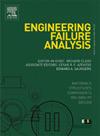Macro-modeling of CFRP strengthening in U-shaped masonry walls under combined vertical and out-of-plane loads
IF 4.4
2区 工程技术
Q1 ENGINEERING, MECHANICAL
引用次数: 0
Abstract
Unreinforced masonry (URM) structures are a critical component of architectural heritage and remain widely used in residential buildings, particularly in developing regions. However, their vulnerability to seismic events necessitates effective retrofitting techniques to improve structural performance. Among various retrofitting methods, fiber-reinforced polymer (FRP) materials, particularly carbon-FRP (CFRP), have shown significant promise in enhancing the strength and ductility of masonry walls. While extensive research has been conducted on the retrofitting of rectangular URM walls, studies addressing the retrofitting performance of U-shaped walls under out-of-plane loading remain comparatively limited, despite their frequent occurrence in practice. Additionally, while vertical loads are known to influence structural behavior, their specific effects on the response of CFRP-retrofitted URM walls require further investigation. This paper presents a comprehensive numerical study investigating the out-of-plane behavior of U-shaped URM walls retrofitted with CFRP strips. A macro-modeling approach with nonlinear homogenized materials using the finite element method is employed to simulate different retrofit configurations, including horizontal, vertical, square mesh, diagonal strips, and fully covered wall faces. The effects of one-side versus both-side attachment, CFRP thickness, and varying vertical loads are also examined to identify optimal retrofitting strategies. Through a systematic evaluation of these variables, this study aims to provide deeper insights into their impact on ultimate wall strength while identifying cost-effective retrofitting solutions. To achieve this, a new parameter is introduced to quantitatively assess the cost-effectiveness of each retrofitting case. The results demonstrate that CFRP retrofitting significantly enhances the out-of-plane strength and overall structural response, with vertical load playing a critical role in modifying strength enhancement. Among the various configurations, the grid layout with extended horizontal strips attached to the side walls was found to provide the highest strength ratio while maintaining a favorable cost-effectiveness balance, making it the most efficient retrofitting strategy. The findings offer valuable insights into the design and application of CFRP-based retrofitting techniques, contributing to advancing knowledge in masonry strengthening and providing engineers and practitioners with data-driven guidance for selecting optimal retrofit strategies.
竖向和面外联合荷载作用下u形砌体墙体CFRP加固的宏观建模
无加固砌体结构是建筑遗产的重要组成部分,在住宅建筑中仍被广泛使用,特别是在发展中地区。然而,它们对地震事件的脆弱性需要有效的改造技术来提高结构性能。在各种改造方法中,纤维增强聚合物(FRP)材料,特别是碳-FRP (CFRP),在提高砌体墙的强度和延性方面显示出显著的前景。虽然对矩形URM墙体的改造进行了广泛的研究,但针对面外荷载作用下u形墙体的改造性能的研究相对有限,尽管在实践中经常出现。此外,虽然已知垂直荷载会影响结构行为,但它们对cfrp加固URM墙体响应的具体影响需要进一步研究。本文对加装CFRP条的u形URM墙体的面外性能进行了全面的数值研究。采用非线性均质材料的有限元宏观建模方法,模拟了水平、垂直、方网格、对角条和全覆盖墙面等不同的改造形态。为了确定最佳的改造策略,还研究了单侧与两侧附着、CFRP厚度和不同垂直载荷的影响。通过对这些变量的系统评估,本研究旨在深入了解它们对最终墙体强度的影响,同时确定具有成本效益的改造解决方案。为了实现这一目标,引入了一个新的参数来定量评估每个改造案例的成本效益。结果表明,CFRP加固显著提高了结构面外强度和整体响应,竖向荷载对强度增强起关键作用。在各种配置中,与侧壁相连的延伸水平条的网格布局提供了最高的强度比,同时保持了有利的成本效益平衡,使其成为最有效的改造策略。这些发现为基于cfrp的改造技术的设计和应用提供了有价值的见解,有助于提高砌体加固方面的知识,并为工程师和从业者提供数据驱动的指导,以选择最佳的改造策略。
本文章由计算机程序翻译,如有差异,请以英文原文为准。
求助全文
约1分钟内获得全文
求助全文
来源期刊

Engineering Failure Analysis
工程技术-材料科学:表征与测试
CiteScore
7.70
自引率
20.00%
发文量
956
审稿时长
47 days
期刊介绍:
Engineering Failure Analysis publishes research papers describing the analysis of engineering failures and related studies.
Papers relating to the structure, properties and behaviour of engineering materials are encouraged, particularly those which also involve the detailed application of materials parameters to problems in engineering structures, components and design. In addition to the area of materials engineering, the interacting fields of mechanical, manufacturing, aeronautical, civil, chemical, corrosion and design engineering are considered relevant. Activity should be directed at analysing engineering failures and carrying out research to help reduce the incidences of failures and to extend the operating horizons of engineering materials.
Emphasis is placed on the mechanical properties of materials and their behaviour when influenced by structure, process and environment. Metallic, polymeric, ceramic and natural materials are all included and the application of these materials to real engineering situations should be emphasised. The use of a case-study based approach is also encouraged.
Engineering Failure Analysis provides essential reference material and critical feedback into the design process thereby contributing to the prevention of engineering failures in the future. All submissions will be subject to peer review from leading experts in the field.
 求助内容:
求助内容: 应助结果提醒方式:
应助结果提醒方式:


